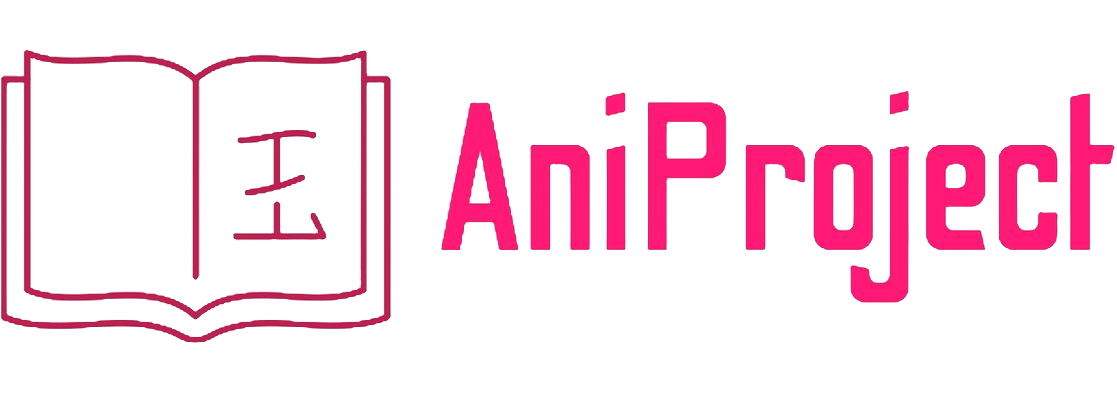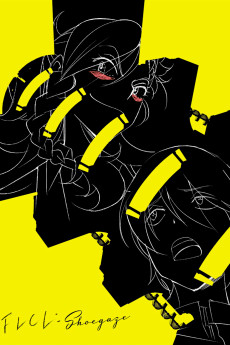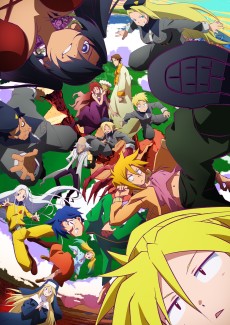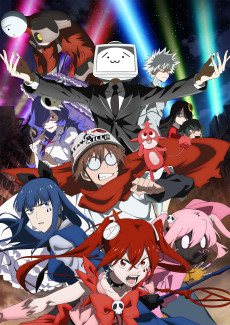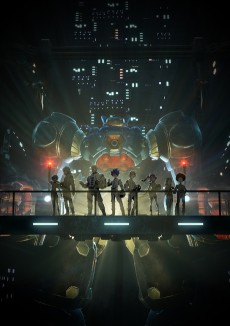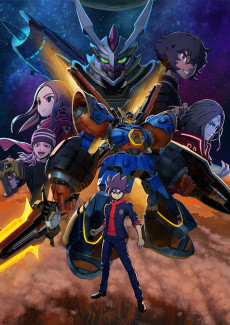FLCL ALTERNATIVE
STATUS
COMPLETE
EPISODES
6
RELEASE
October 13, 2018
LENGTH
25 min
DESCRIPTION
The series centers on the misadventures of 17-year-old Kana, a high school junior who spends her days hanging out with her besties, Mossan, Hijiri, and Pets. They live unremarkable lives, until the day a Mecha falls out of the sky, along with a strange woman named “Haruko.” Her plans for Kana and her friends involve the force known as “ATOMSK.” Kana will have to risk everything to decide whether or not to help… like she really has a choice!
(Source: Adult Swim)
CAST
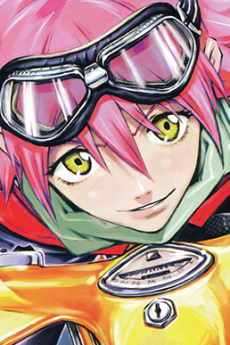
Haruko Haruhara

Mayumi Shintani

Kana Koumoto
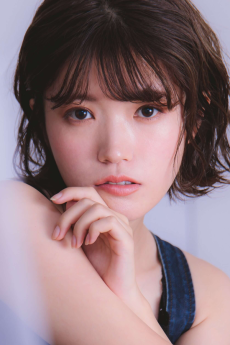
Karen Miyama
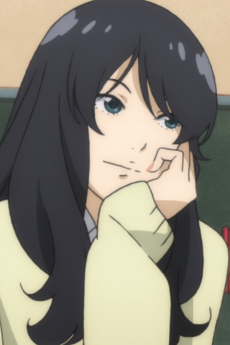
Hijiri Yajima
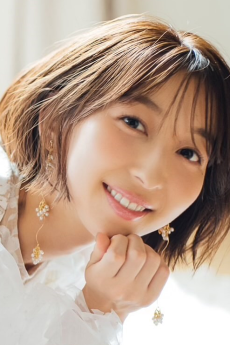
Riho Iida
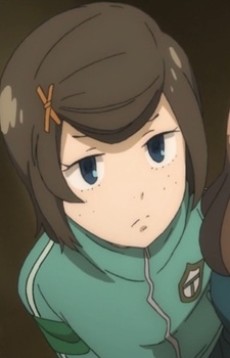
Tomomi Hetada
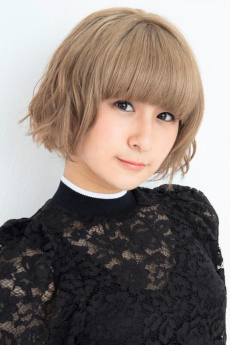
Yuri Yoshida
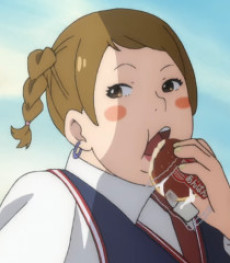
Man Motoyama
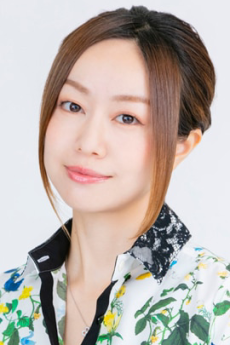
Mutsumi Tamura
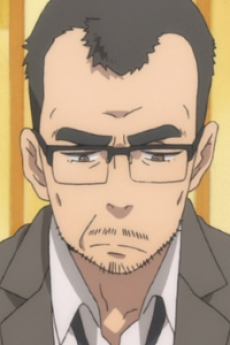
Tsukata Kanda
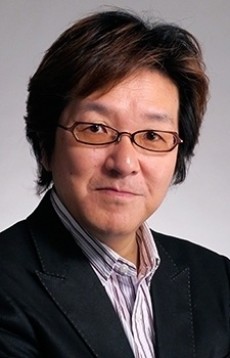
Yutaka Aoyama
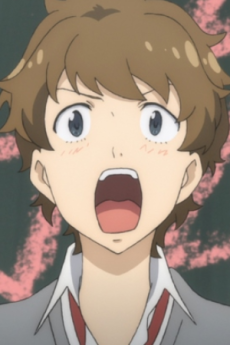
Mon Sasaki
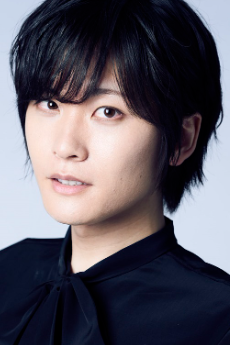
Takuma Nagatsuka

Dennis Yoga

Katsuji Mori
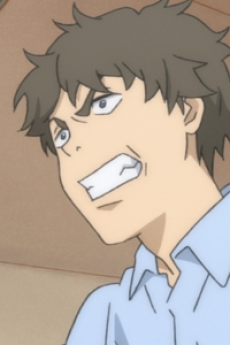
Kan Sudou
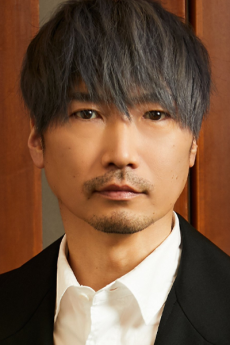
Katsuyuki Konishi

Mimi Hedeta
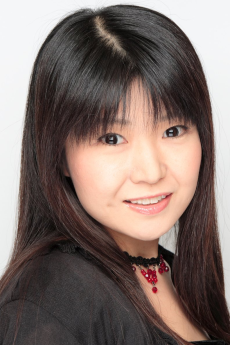
Yuki Matsuoka
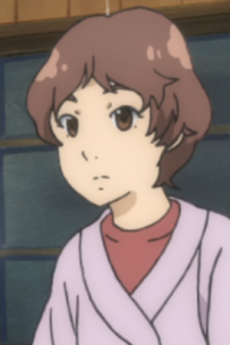
Shizuka Koumoto
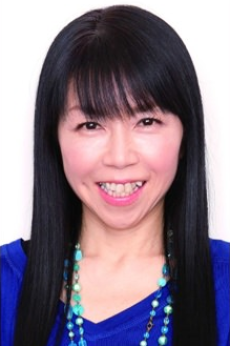
Miki Itou
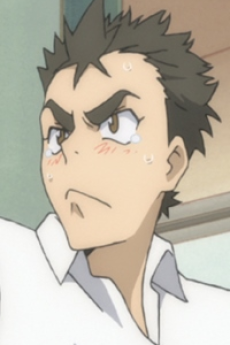
Ben Aida

Ryouta Suzuki
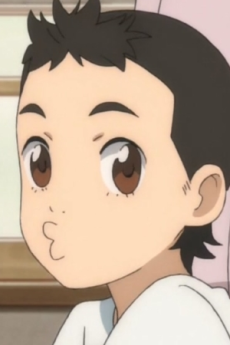
Bunta Koumoto
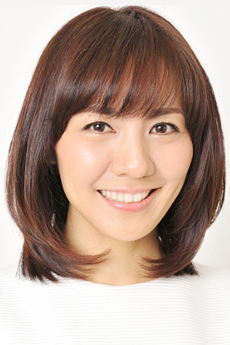
Miho Masaka
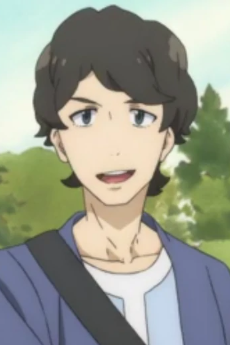
Toshio Shioya
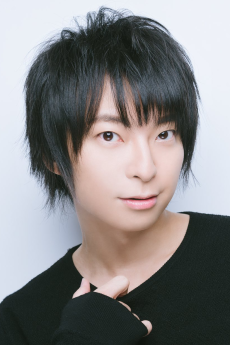
Tetsuya Kakihara
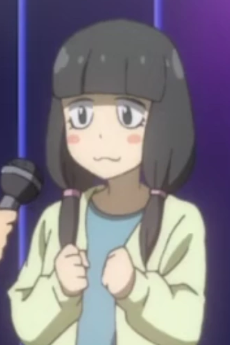
Hana Tondabayashi
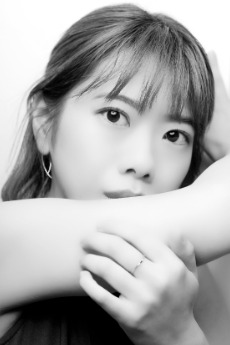
Yumiko Rin
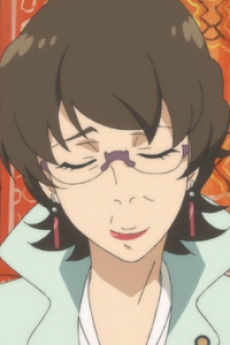
Maki Kitaki
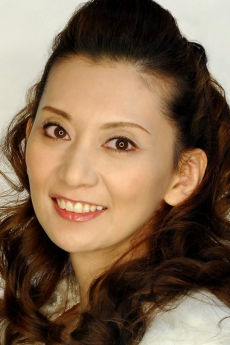
Kaya Matsutani
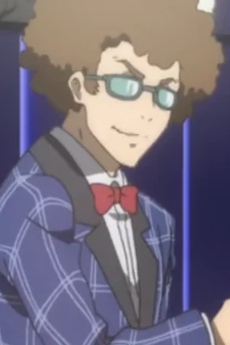
MC
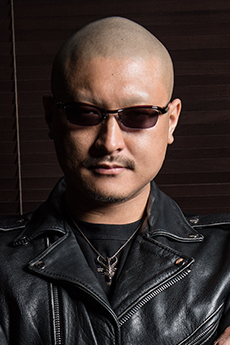
Mafia Kajita
EPISODES
Dubbed
RELATED TO FLCL ALTERNATIVE
REVIEWS

planetJane
86/100The final Fooly Cooly asks a very simple question: is there love left on this doomed little planet of ours?Continue on AniList_“High school girls sure are complicated.” --Haruko Haruhara, Episode 6_ 
And so ends one of the most profoundly odd trilogies in the entire medium. FLCL, FLCL Progressive, and FLCL Alternative. What’s maybe most striking about the three entries in what is now a franchise is how different they are from each other despite working off the same “core” premise. The original still exists, to some extent, upon a pedestal. It is a bizarre, ever-shifting thing, both literally (the series was originally conceived as a way to experiment with animation after all) and thematically, and any analysis of it that attempts to be brief and snappy is doomed to fail. Progressive is a darker, and, lord help me for using the word positively, grittier take on the idea. Recasting the villainous but charming Haruko as the much nastier Haruha, and replacing the self-important but lovable Naota with the deeply depressed violence fetishist Hidomi. Those two form a part in of themselves, as much of Progressive’s raison d’arte is to cast a skeptical, leering eye toward the original FLCL, sometimes seeming to question as to whether making the villain so charming is a good idea, and whether maybe the series is a bit too open to interpretation altogether.
Where does that leave Alternative? The final entry in the trilogy, and in some ways, a bit of a rebuttal to Progressive’s audience-antagonizing take on the series. More than that though, Alternative--at least initially--seems like it has much less to say about FLCL and much more to say about, well, stuff in general. In a strange sort of sense, this makes it rather “traditional”, to the extent that a franchise like FLCL has traditions to return to.

If Alternative has an overall theme, it is probably something like this; “People fuck up”. Specifically, our protagonist, 17 year old Kana, fucks up. A lot. In a broader sense, so does almost everyone else in the cast. Kana’s three friends--Hijiri, Mossan, and Pets--each get a focus episode (in a half-cour series, really) in which they make some kind of mistake. Hijiri is caught in a hookup with a college-aged boy, Mossan attempts to shoulder the burden of working up enough money to attend a fashion school on her own, and Pets….is rather complicated. Kana--and Haruko, here in a much more heroic role than her turn in Prog and indeed even the original--helps to solve these problems in her own way, which turns out in the grand scheme of things, to be something of a fuckup in of itself, in the last episode she admits her propensity to help others at the expense of her own wellbeing to be, basically, an act. Something done for her own sake.
The last episode, interestingly, brings back some of the metatext that made Prog as good as it was (or more properly, reveals what's been there from the start) and at the end, FLCL, one of the most strikingly original anime of all time, has its sequel duology go out like a shonen series. All stammered speeches about the power of love and 11th-hour super-powers to rewrite reality and scratch together a happy(-ish) ending at the last minute. Does that sound like a complaint? It isn’t, though it’d be foolish to expect answers from FLCL of all things, the final episode of Alternative is jam-packed with conversation with the show’s predecessors--not just Progressive (the “I don’t know what I want” segment of Kana’s speech echoing Hidomi’s “there’s nothing I want to be”) and the original FLCL (full-on flashbacks as Haruko appears to be flung sideways in time at the series’ conclusion)--but the rest of the Daicon lineage too, most saliently, Diebuster, whose ending this series’ finale somewhat mirrors. Nono’s black hole sacrifice recontextualized as an act of self-empowerment and seizing control of one’s life.

This is without even getting into the minor details; The fan bait that is the Steve Blum-voiced soba shop owner talking about making soba until the end of the world, a statement it’s hard to not read on a meta level as being about the perpetually half-dying anime localization industry. The scarily prescient idea of the richest and most powerful citizens of Earth fleeing to Mars in the face of a doomed planet.The knotted timeline which I can only imagine the most devoted fans will be trying to untangle for years. Alternative even, in parts of Kana's speech in the finale and an earlier conversation in the same episode, joins A Place Further Than The Universe as the second series this year to openly criticize the "endless everyday" concept that is foundational to the slice of life genre, and subsequently, much modern anime in general. There’s a lot to Alternative, which is both its greatest strength and greatest weakness.
If anything, I suspect Alternative will work for even fewer people than Progressive. Prog relied on having a working knowledge of the original series and hearts in your eyes for Haruko. Alt cranks that up to eleven and rips the dial off. Invoking the original, Prog, Diebuster, anime youth dramas, and so much more. It’s a lot to ask of the audience, and depending on how you view these sorts of things, you could argue that Alt doesn’t really stand on its own legs. After spending four of its six episodes seeming like it was unconcerned with the series’ legacy, Alt turns out to have the most relationship to the rest of FLCL out of almost any other work in the franchise--the manga adaptation of the original included. This structure can also make the first half of Alternative feel a little aimless, so it’s definitely not a strategy that works perfectly, but of the three six-episode series, Alt might--if only just barely--actually prove to be the most rewarding in the long run, both in how it interacts with the rest of the series and its commentary on the real world. It’s a hard thing to call, but if the original FLCL proved anything way back when it aired at the dawn of the new millennium, it’s that you can be weird, be difficult, be obtuse even, and still have people respect what you’re trying to do, and maybe even love it.
If there’s a note to close on, it should be this; In a world that feels doomed, works like Alternative are cathartic, even important. A hard-fought struggle for love on a planet that seems like it’s lost it, in 2018, by design or by simple applicability, is something worth praising.


CodeBlazeFate
73/100This laid-back alternative is as unnecessary as it is welcome, and welcome's all it ever needed to be.Continue on AniListFLCL Alternative is an interesting show. Accidentally brought early for April Fool’s day, FLCL’s lax cousin was forced to bear the burden Progressive was supposed to have, that being the weight of being the sequel to a legendary piece of animated passion. It was stuck with that again after Progressive turned out the way it did and paid the piper for it in terms of reception. For bearing such a Herculean task, this show was oddly calm, even nostalgic in some ways. It’s a miracle it worked at all given its approach.
One obvious point in this show’s favor is that it actually tries to tackle something different from the original. Progressive focused more on adding intrusive lore elements to Haruko while providing unnecessary and flawed critique for the sake of a character arc. It sidelined its own protagonist’s role, leaving its core messages and delivery half-baked. Alternative takes a new angle entirely, focusing on a group of four teenage girls on the verge of adulthood rather than the beginning of adolescence. From there, it begins studying our main leads one by one in the first half, while sandwiching them with the style and structure of FLCL.
What makes this work is the sense of chemistry our main leads have. Each interaction feels as lovey and genuine as these girls’ distinct personalities. This makes studying them individually and what makes them a part of this group so rewarding. It shows off all their jobs, passions, and struggles, which make each girl feel almost real. Adding onto this genuine feeling is how organically the show taps into teenage culture. These girls hang out at restaurants and malls, text each other, and visit each other’s houses to learn about each other and hang out more. Kana, Hijiri, and Mossan are particularly fun to watch and explore, and even Tomomi -the character who often just blends in while making humorous jabs- gets her time to feel like a true member of this lively cast. Seeing Mossan’s little siblings draw food to “pretend feed” her, and how tired she is while she works, tells us more about her than the exposition her mom gives to Kana. Kana’s bookbag charms and cracked phone screen tell us about her character better than any thankfully non-existent exposition dump does. Hijiri’s forlorn sigh after her break up tells more than any exposition dump does. Most refreshingly, some of the scenes of characters talking about each other reveal more about themselves and their dynamic than the people they’re referring to. It all melds together to forge this small community of girls to get attached to.
The fact that even with this, Haruko trumps all, is easily the most astounding part. She is what ties everything together in the nicest of bows. Her absurd occupations are as glorious as the fact that as long as she gets her job done, she legally has jurisdiction —in universe— to do whatever the fuck she wants. As such, she can go from being a nurse and a food truck vendor to someone slaying Bumblebee while shouting “Michael Bay” in a 3D action sequence! She’s every bit the force of nature she once was, now with an entirely different purpose and even more insight. The monumental performance by Kari Wahlgren truly exemplifies what a joy this incarnation of Haruko is to watch. Her main redesign also reflects this wonderfully while being as great as her original design. Not every appearance feels necessary, but they are generally some of the highlights of any given episode.
This isn’t to say Alternative’s writing is perfect, even in terms of living up to its predecessor. The writing can be a bit too blunt, even if it doesn’t always spell out each episode’s message. It doesn’t have the sense of subtlety the original had. At times, some dramatic scenes can feel boilerplate, as if they did it just to have one. The same also applies to some of their attempts at incredibly weird and visually varied sequences that really drag on and feel more awkward than bombastic. Another, more important issue is that for 2/3 of the show, there’s no real sense of escalation or reason to care about the grander narrative. What makes matters worse is that the middle section feels more undercooked and wasteful than anything else, especially since a short 6-episode series should have no reason to buy time. On top of that, the main reasoning behind the conflict of episode 5 really doesn't add up when you think about it, which is criminal considering that episode 5 is the turning point for the show. Thankfully most of these writing issues aren’t deal-breakers, especially compared to the more damning flaws in Progressive. It does further solidify how the original was the most solid installment.
On the subjects of improving, let’s address the visuals. The animation feels livelier, more fluid than the often stiff and awkward-feeling animation presented in Progressive’s action sequences. It isn’t as fluid as the original, and there are some rough moments —both in the animation and CGI department-- but the visuals are far more vibrant and less awkwardly restrained as they were previously for the most part. Additionally, the character expressions are far more lively here to boot. Combine this with Haruko’s numerous hairstyles and clothes this time around, and some more interesting designs for the one-off enemies of each episode, and it’s not hard to see how this was a step above the previous entry.
Finally, we arrive at the audio improvements. The dubbing here was even better than before. This includes both the main and/or returning characters, and with the glorious additions of Steve Blum and Patrick Seitz. However, the biggest step up is in the music. Where Progressive only really had one track of note —that being “Thank You, My Twilight” by The Pillows— Alternative doubles that with two of the best tracks in the franchise. “White Summer and Green Bicycle, Red Hair and Black Guitar” is easily my favorite insert song in the franchise, with a wonderfully nostalgic feeling to it that makes reflecting on a walk or bus ride a marvelous experience. None of the other tracks match up, but they are at least serviceable. The absolute splendor of these two tracks by The Pillows is already enough to show how much more effective this show was than its predecessor.
FLCL Alternative may not match the original’s sheer passion, subtlety, skill, or visual splendor, but it keeps the spirit moving in a new direction. It switches gears organically, embracing itself as its own justified identity while keeping true to its roots, even if it isn’t always successful at that. This laidback alternative is as unnecessary as it is welcome, and welcome's all it ever needed to be.
Written and edited by: CodeBlazeFate
Proofread by: Peregrine
Pockeyramune919
91/100An alternative take on the FLCL formula that progresses the series to new heights.Continue on AniList[
 ](https://anilist.co/review/3981)
](https://anilist.co/review/3981)[
 ](https://anilist.co/review/22680)
](https://anilist.co/review/22680)_Part ⅗ of the FLCL Review Series_ 
Well, it’s certainly been a ride. I had a close encounter with a pink-haired vixen of an alien and ever since then, I’ve had to battle the mechanical monstrosities that have sprung forth from my forehead. I’ve been battling them every day, but here I am, presenting you the final entry in my FLCL review trilogy
, with a corny intro, to boot. I felt compelled to write this not just because I strive to finish everything that I start, but because this series meant a lot to me. It’s almost poetic— both FLCL and my review series of it had a significant gap between entries.But enough dilly-dallying, this is FLCL Alternative, the third in what is now a trilogy. While I thought it was pretty good, fan reception of Progressive was quite sour. How does Alternative fare in comparison?
Quite well, actually. FLCL Alternative is a worthy successor to FLCL Classic, being quite a bit better than Progressive. In fact, I’m going to go ahead and make you scroll for that dislike button right now by saying that I enjoyed FLCL Alternative more than Classic.

FLCL tells the story of Kana Koumoto, an energetic seventeen-year-old girl who enjoys spending her days with her best friends, Tomomi “Pets” Hetada, Man “Mossan” Motoyama, and Hijiri Yajima. Under a twilight haze that harkens back to the opening where Naota and Mamimi hung out near an overpass, Kana boredly states that the days are all the same, with yesterday being like today, which in turn will be similar to tomorrow. Words that seem to hint at dissatisfaction turn out to be words of comfort to Kana who is unsure of her future during this time of transition. She can rest easy that, for a time, things will stay simple. When Kana and co. decide to create a bottle rocket on a whim, however, a Medical Mechanica robot trashes their hideout. Along with it comes a familiar pink-haired woman. By now, we know that a visit from Haruko signals that nothing will be simple ever again.

Just from the premise, Alternative is off to a great start: its story is an inversion of Classic in some ways. Instead of a person who wants to grow up, our main character is someone who wishes to continue living their days as a teenager. So does the rest of the package live up to good first impressions?
If you’ve forgotten, for FLCL reviews, I judge the art/animation, the music, then the story.
I hate starting off with the art for Alternative, because it isn’t its strong suit when comparing it to the FLCL Classic. My memory’s probably faltering, but I swear, at the very least, it’s better than Progressive’s. FLCL Alternative’s art direction helps the anime stand apart visually from its contemporaries and, once again, the lighting reminds me of Classic, so better than Progressive, Alternative will get those nostalgia trains running. Unfortunately, Alternative’s art, as good as it is, still doesn’t hold a candle to Classic. It’s almost not fair considering how phenomenal Classic’s art is, but as a sequel, viewers expect art of similar or higher caliber. Still, even if not amazing, the art of Alternative is pretty great.
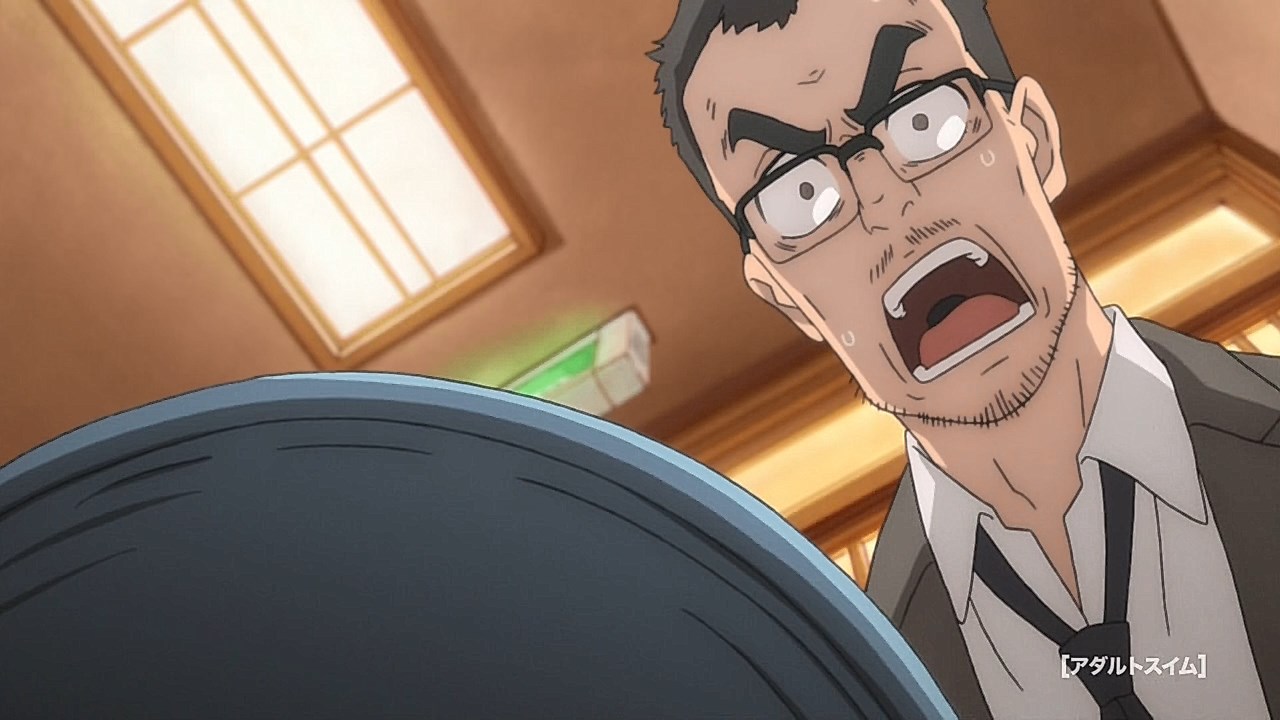
And of course, FLCL wouldn’t be FLCL without its animation or rather, its animation shifts. Again, starting off with this might make one think the show has no merits. I’d say Alternative uses animation shifts even less so than Progressive. They’re there, but they’re often the flavor of “a character briefly looks strange for comedic effect,” a technique that most comedy anime employ. There are a few more substantial art shifts, arguably made more funny and impactful due to how sparse they are now. Again, FLCL Alternative falls short of Classic in this regard, but it does well-enough and I appreciate it doing its own thing. More on that point in a bit.
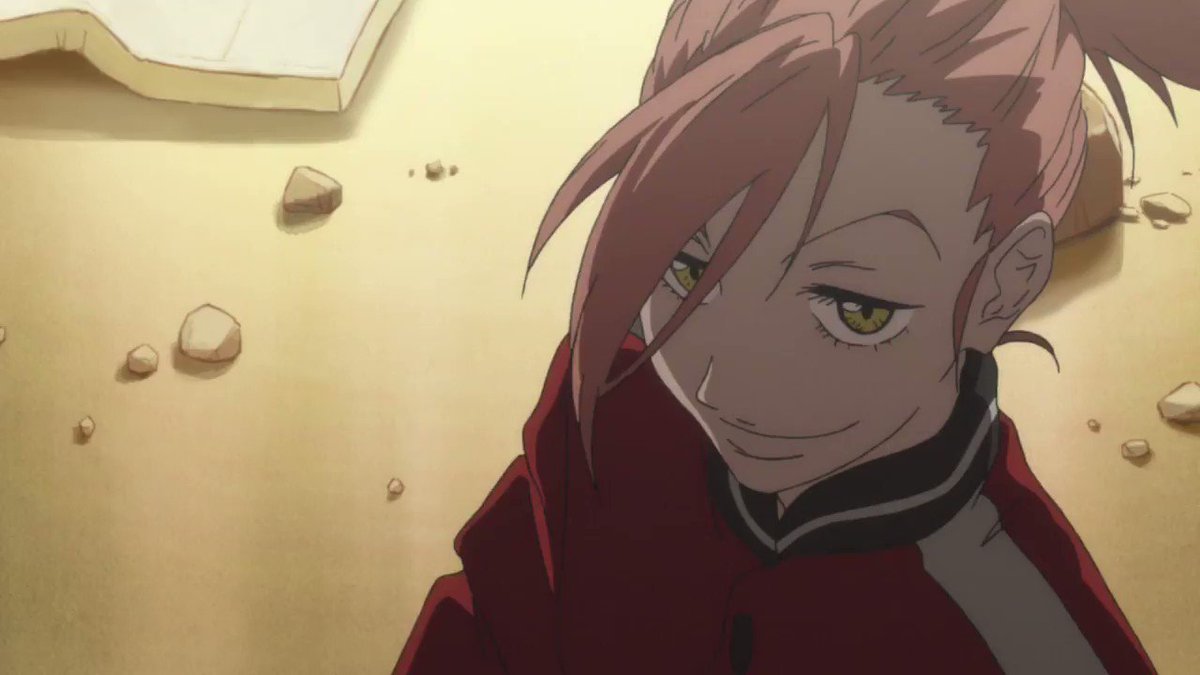
Onto the music! It’s great! I’m glad I can say “the music is great” without saying “but” at the end! It’s standard The Pillows fare, but it’s standard The Pillows fare, so it’s automatically awesome! If you loved the soundtrack of FLCL Classic, you’ll equally love the music of Alternative. I think I’m gushing so much about the music because I can actually hear it again! I think out of the three seasons, Alternative technically has the least songs, but the sound mixing seems better than Progressive.
Also, just as an aside: the original FLCL can be compared to a music video. Funnily enough, the middle of episode one of Alternative features a literal music video for the new ending theme, Star Overhead.
Now, onto the characters and story, and this is where FLCL Alternative really shines; brighter than both Progressive and Classic, in my opinion.
First off the characters: Kana and her crew. They were such fine additions to the FLCL universe. I loved spending time with them and learning about their quirks, personalities, and problems. Moreso than Naota, Hidomi, or Iide, I actually see how the main character interacts with people and I really appreciate it. I really came to care about the main characters and their struggles since they were so fleshed out. Each of the first episodes serve as a day-in-the-limelight for members of the group. They’re all given enough focus, thus solving the problems I had with Iide, and their personalities/circumstances lend them to being interesting and open, thus solving the problems I had with Hidomi. It’s probably sacrilegious to say, but I think my attachment towards Naota is more due to nostalgia, than anything. More than Naota, I felt like Kana’s arc did a better job of earning my interest in her as a character. I especially loved Mossan. She was more than just a fat stereotype. Besides loving food, she had actual goals and aspirations.
As always, Haruko is a joy to watch. It’s interesting to note how her role as a protagonist and antagonist can change, but she still feels like Haruko. In Classic she was ambiguous, but leaning towards a villainous antagonist, she’s strictly a villain in antagonist in Alternative, and this is the most heroic we’ve seen her. And she’s still completely bonkers. And I still love it.

Moving on to the story. The Space Opera aspects were there, but mostly saved until the final two episodes. If you’re here for that aspect of the plot, then you might be disappointed, but things really are down to the wire, even more than Progressive. The stakes are higher than ever. If you stick around, you’ll be in for a treat.
If you’re in for the coming-of-age story, you’ll enjoy FLCL Alternative at least a bit, I guarantee it. This aspect of the show is why I regard it so highly. With six episodes, it does a good job of showing the conflict of being an older teenager, and resolves it nicely. Kana’s feelings are made clear and unlike Classic and Alternative, the plot isn’t ambiguous, which I appreciate. While there weren’t as many random moments, there were more sentimental moments, which made Alternative a better story than the original. I even enjoyed the Commander Amarao analogue (Tsukata Kana) better than Amarao himself. Sure, he was less funny, but I cared about his character more.
Which isn’t to say FLCL Alternative doesn’t have its laugh-out-loud funny moment. There’s a part when Haruko breaks into a rap, there’s a part where there’s a random basketball game, and there’s a part where Kana is drawn in a bishoujo style, among others.

Comedy and high-octane energy isn’t the focus of Alternative, however.
And that’s okay.

I see the aptly named FLCL Alternative as an alternative take on the original FLCL — focusing on the characters, plot, and coming-of-age aspect rather than the animation, action, and comedy. I don’t mind, I can actually comprehend the plot as a whole and I thoroughly enjoyed it. Remember how I said Progressive took too much of what didn’t work about FLCL Classic and not enough that did? Alternative is the opposite: leaving behind what didn’t work and taking everything that I loved/wanted in the original.
Even if it’s not as good as I make it up to be, it’s a good watch. While it’s a bit slower to get though than the original, I think I ultimately left with more after viewing.
Unfortunately, it seems like the fan reception of Progressive has caused many to skip out on Alternative, and that’s a shame. It’s a wonderful show, and I wish more people watched it. I want to read articles on Alternative, I want to have discussions about the show’s themes, I want others to help me make sense of the ending. If nothing else, I hope this review raises awareness of this criminally underrated and under watched gem of 2018.

SIMILAR ANIMES YOU MAY LIKE
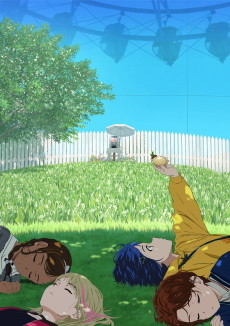 ANIME ActionWonder Egg Priority
ANIME ActionWonder Egg Priority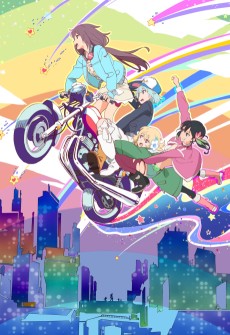 ANIME ActionRolling☆Girls
ANIME ActionRolling☆Girls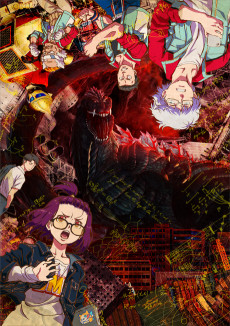 ONA ActionGodzilla: Singular Point
ONA ActionGodzilla: Singular Point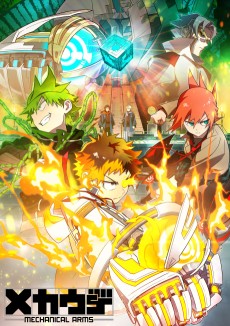 ANIME ActionMecha-ude (TV)
ANIME ActionMecha-ude (TV)
SCORE
- (3.15/5)
TRAILER
MORE INFO
Ended inOctober 13, 2018
Main Studio Production I.G
Favorited by 216 Users
Hashtag #FLCL

